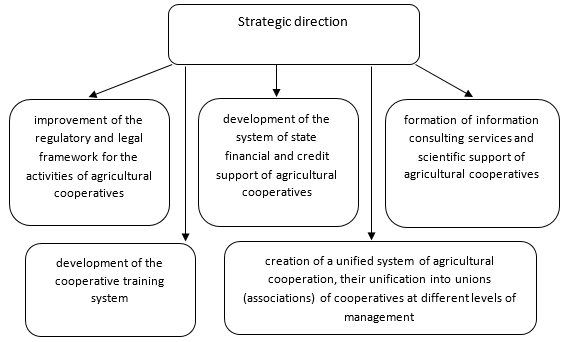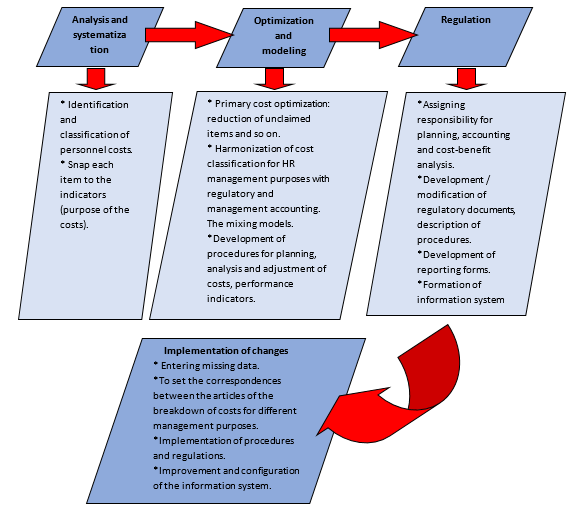One of the priorities of the agro-industrial complex (AIC) of Kazakhstan is the development of agricultural cooperation by combining small businesses, the development of small and medium-sized businesses, the effective organization of the system of promotion of agricultural products from producer to consumer. The relevance and priority of this direction is confirmed by the adoption of a number of policy documents in recent years: “Agribusiness-2020”, “Strategy-2050”, “Business Road map-2020”, “Nurly-Zhol”, the State program of development of agriculture of Kazakhstan for 2017-2021, etc. One of the main program activities of the State program of development of agriculture of Kazakhstan for 2017-2021, adopted on February 18, 2017, is the involvement of small and medium-sized farms in agricultural cooperation.
The main problem of effective development of agriculture is the small-scale nature of production, accompanied by a high proportion of small farms in the total volume of gross agricultural output, the total number of agricultural units, the tendency to reduce their land holdings. According to the Committee on statistics in 2018, the share of households in the total gross agricultural output amounted to 43.4%, including in the production of livestock products – 70%, the share of farms is high in crop production – 37.9%. There is also a tendency to reduce the number of large agricultural enterprises and the size of their land plots. Since 1995, the number of production cooperatives decreased by 1.6 times, and the average size of their land use by 6 times, respectively, land plots of LLP and JSC decreased by 2.3 times, farms – 1.8 times [1].
The dominance of households in the structure of agriculture hinders the development of the industry. The predominance of peasant slaughtering, non-compliance with sanitary standards, weak food supply and technological equipment of processing enterprises with appropriate equipment affect the quality of products. Small-scale agricultural production does not allow to carry out large-scale selection and breeding work, to observe scientifically grounded crop rotation, to use modern technologies, etc. Most small farms are not available measures of state support in the form of subsidies, investment subsidies, preferential loans, in connection with insufficient volume of production, area sown and the presence of livestock, the relevant requirements of state programs, as well as in the lack of collateral from smallholders for the purchase of credits. The low level of income, high interest rates on loans, a significant level of risk of small and medium-sized businesses do not allow to provide start-up capital for business development in rural areas, to finance expenses in the pre-season period of working capital, equipment, new technologies.
All these forces agricultural producers to organize their own joint activities for the production, sale, storage and processing of agricultural products, logistics and maintenance of agricultural producers without intermediaries on a cooperative basis.
Modern world practice, as well as domestic experience show that the progressive development of agriculture will largely be determined by the use of the benefits of cooperation. The output of the agricultural sector to a higher level of development involves the widespread use of effective models of cooperation. Agricultural producers that are not connected with coordination relations with processing and trade and sales enterprises will not be able to effectively sell their products, will be forced to contain all kinds of intermediaries [2].
The main socio-economic task of agricultural cooperatives is to create an organizational and legal system to protect the interests of agricultural producers in market conditions by creating a democratic self-governing form of management. In order to solve the existing problems in the agro-industrial complex of the Republic, especially small forms of management, the need to adopt new approaches to the organization of production, ensuring the stabilization of the economy of agriculture, based on cooperative principles.
Based on the existing problems of development of agricultural production, the authors note the need to remove all barriers to business development in agriculture, the process of cooperation of farming, efficient land use.
The main barriers to cooperative farming include:
* high level of distrust of agricultural producers, especially small businesses, to new structures being created, fear of losing the only means of land production;
* low level of legal culture in rural areas, lack of awareness of farmers about the benefits of agricultural cooperatives (a special form of production organization aimed at joint management, control, financing and use of labor results);
* imperfection of the regulatory framework governing the activities of cooperatives (the presence of many laws characterized by repetitions and contradictions), the lack of specialized coordinating and supervisory bodies (associations, etc.), regulating the legal, organizational and economic conditions for the creation of agricultural cooperatives, which led to their incorrect registration, accounting, distribution of income and other violations of cooperative principles [3];
* lack of incentives for farmers to join agricultural cooperatives, in particular the inability to distribute the net income of the cooperative (established in the form of non-profit organizations) among its members;
* imperfection of the existing mechanism of state support of agricultural cooperatives (insufficient funds allocated for the provision of concessional lending through JSC “agrarian Credit Corporation”, while concessional lending and taxation are available only to one form of cooperatives to rural consumer cooperative, and other forms (rural consumer cooperative of water users, production cooperative, agricultural partnerships, etc.) – is not available [4].
Analysis of existing agricultural cooperatives, trends of their development allowed to develop the following strategic directions of development of agricultural cooperation in Kazakhstan (Fig.1).
Figure 1 – Strategic directions of development of agricultural cooperation in Kazakhstan

Note: compiled by the authors on the basis of the studied material.
One of the factors of effective development of agricultural cooperation is the provision of information and consulting services. In order to form information consulting services and scientific support of agricultural cooperatives, we propose a two-level model of information and consulting services for the development of cooperation [5].
The creation of a unified system of agricultural cooperation, their association in unions (associations) of cooperatives at different levels of management is one of the main directions of the Strategy of development of agricultural cooperatives in rural areas, which is a set of cooperatives of different types and levels, in organizational, legal and functional relations, united at the state, regional and district levels (Fig.2).
Figure 2– Management of the process of cost optimization in agricultural cooperatives of the Republic of Kazakhstan.

Note: compiled by the authors on the basis of the studied material.
It is recommended to gradually form a multi-level system of agricultural cooperatives, acting in conjunction with the state (local) bodies through the formation of the coordination Council and working groups of consultants on the organization of forms of agricultural cooperation at the district level, as well as their interaction with financial, public and other organizations [6].
In conclusion, the management of the process of cost optimization in agricultural cooperatives of the Republic of Kazakhstan provides:
– implementation of pilot projects for the development of agricultural cooperation and synthesis of their results;
– advising employees of the Ministry of agriculture of Kazakhstan and other ministries and agencies on the organization of regulation of the cooperative movement;
– training and consulting of employees of the regional information and consulting system and regional training centers.
Sources used
- Bekezhanov, D., Yerkinbayeva, L. (2017). Legal regulation of municipal solid waste treatment in the transition of developing countries to ‘green economy’. Journal of Advanced Research in Law and Economics. Volume VIII, Issue 3(25). Page 754.
- Dietrich, Berner. (2004). Trends in the development of production, processing and marketing of agricultural products. Almaty. P. 11.
- Iskakov, A.J. (2010). Agriculture of the Republic of Kazakhstan: yesterday and today. Journal Bulletin of the Treasury. P. 22.
- Katkov, Yu. N. (2011). “Target costing” and “Kaizen costing” in cost optimization and the calculation of the cost of agricultural products [electronic resource]. Consultant: [website inform.- legal company]. “Accounting in agriculture”. № 8. Access mode: http://financier.consultant.ru/pbi/list/2011/1007.html
- Program “Agribusiness 2020” [Electron. resource.]. (2013). 18 Feb.URL: http://www.mgov.kz (date accessed: 05.2019).
- Shalaeva, L. V. (2012). Modern cost management systems as the most important tools of strategic management accounting [electronic resource]. Garant: [website inform.- legal company]. “International accounting”. N 21. Access mode: http://www.garant.ru

